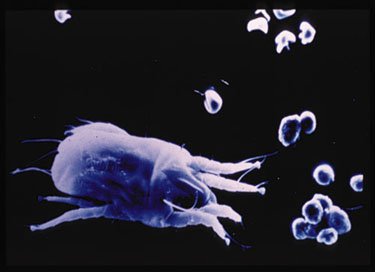Hypersensitivity of the human immune system
By Helena Chui and Aries Poon
 |
| The dust mite is only 0.3 to 0.5mm in size |
Pollen allergy is caused by allergens found mostly in pollens from grasses and trees.
Allergens are substances, mainly protein, causing allergies. If people having allergic tendencies inhale, eat or have contact with the allergens, their immune systems may overreact and produce a particular antibody which makes people develop the allergic symptoms.
"Pollen allergy is not common in Hong Kong because there is not much vegetation in the Territory," said Dr. Roland C.C. Leung, an associate professor in the Department of Medicine at The Chinese University of Hong Kong.
Besides pollen allergy, there are many different kinds of allergies. Skin rash, runny nose, allergic rhinitis, asthma and hives are some of the common allergies.
A Miss Kam of Sha Tin, who asked that her full name be withheld, suffers from nasal allergy, itchy skin and cosmetic allergy.
"It is annoying especially when my face becomes red and my appearance is bad," said Miss Kam.
Miss Kam is not alone — nor she is the most serious case. About 40 to 50 percent of the world's population will potentially develop allergies.
Allergies can lead to death. In May 1995, Taiwanese songstress Teresa Tang Leih Kwan died of asthma in Chiang Mai.
Furthermore, the human immune system can overreact to some common drugs and bee stings. In both cases, allergies can be fatal.
Said Dr. Leung: "The most common drug causing allergies is penicillin. Whether one is allergic to it can be discovered by blood and skin tests."
If a person allergic to bee stings is stung by bees more than once, the second reaction may be so severe that death results. But there are means of prevention.
"Death from bee stings can be prevented completely by treatment," said Dr. Leung. For food allergies, the allergens mostly come from wheat, fish, nuts and milk.
"Although protein in cow's milk causes allergic symptoms, that in the human milk doesn't," said Prof. Michael Tam of the Department of Physiology at The Chinese University of Hong Kong. "Therefore, breast feeding is the best," he added.
Other than protein in cow's milk, the more the exposure to allergens, the more likely babies will develop allergies. However, this depends on other factors.
Said Dr. Leung: "People without allergic tendency will never develop allergies even if they are exposed to lots of allergens."
 |
| Skin test for allergy to penicillin. |
Besides, babies have a greater chance of having allergic tendencies if the mothers are smokers.
"People with allergic tendencies will develop symptoms only if they are exposed to allergens," said Dr. Leung. "Some do not even know they have such tendencies throughout their lives."
Preservatives, artificial colourings and flavourings can also trigger off symptoms among people with allergic tendencies.
Hairy animals like dogs, horses, mice, rabbits and especially cats cause allergic symptoms as well.
Asthma and skin disorders are usually triggered off by the faeces of a tiny creature called the dust mite. Not generally visible to the naked eye, it lives in beds, curtains, carpets, dolls and books. The presence of pets encourages larger populations of dust mites.
Dust mites' faeces contain many allergens. When people with allergic tendencies inhale or contact the faeces, symptoms appear.
Unless materials such as old books, pillows and blankets where dust mites live are removed from the home environment, dust mites can never be totally eliminated.
Many people have the mistaken belief that air pollution is a major cause of allergies.
"The air pollution in Guangzhou is more serious than that in Hong Kong. However, only 4 percent of children in Guangzhou suffer from asthma, but 12 percent of Hong Kong children suffer," said Dr. Leung.
But if people are specifically allergic to some pollutants, pollution may elicit the allergic symptoms of the sufferers. Meanwhile, many pollutants are common inside Hong Kong households rather than in the atmosphere outside.
Said Dr. Linda Koo, lecturer in the Department of Community Medicine at The University of Hong Kong: "I have come to realize that indoor, self-created pollution does contribute to more and more respiratory allergies such as chronic cough, asthma, allergic rhinitis.
"The most obvious source of indoor pollution is the incense produced in some religious rituals," said Dr. Koo.
This may explain why many nonsmokers still have some kinds of respiratory allergies.
Since some allergens such as dust mites, secretions of cockroaches and mould are difficult to avoid, drugs are used to suppress the symptoms.
Eighty-five percent of children who have allergies find symptoms disappear when they enter adolescence. Nevertheless, symptoms may revive when they reach their 50s or 60s.
"There is no cure for allergies. All we can do is to control the symptoms to reduce the level of occurrence," Dr. Leung concluded.

January 1997
Return to contents
